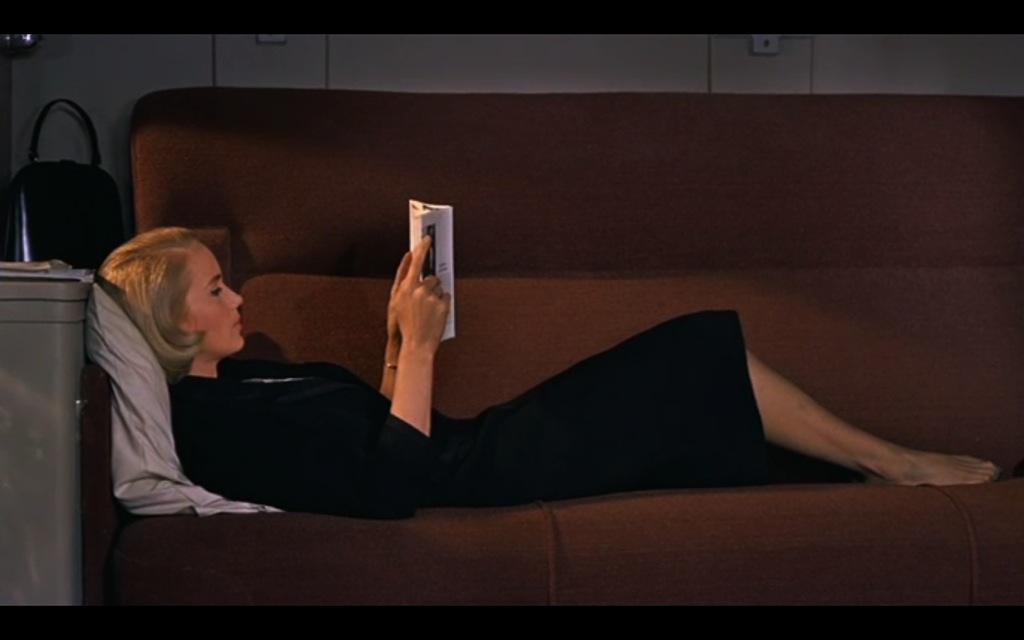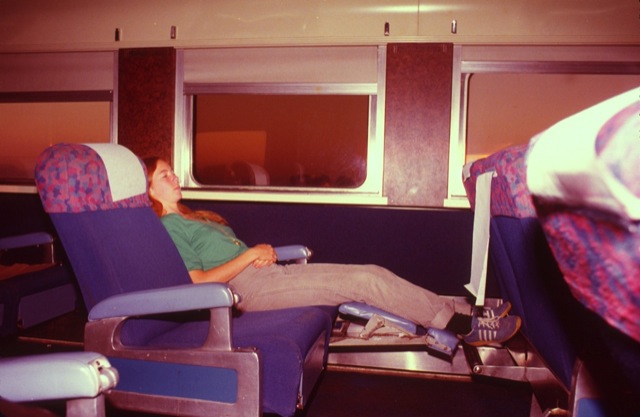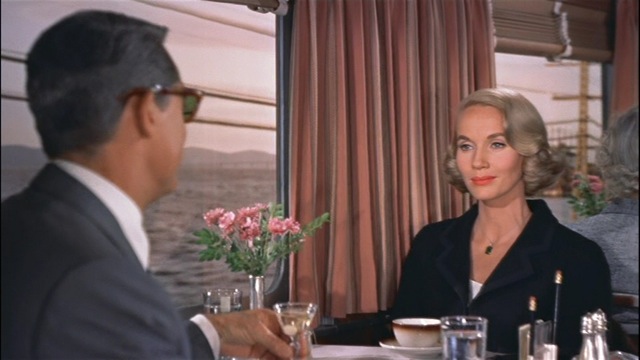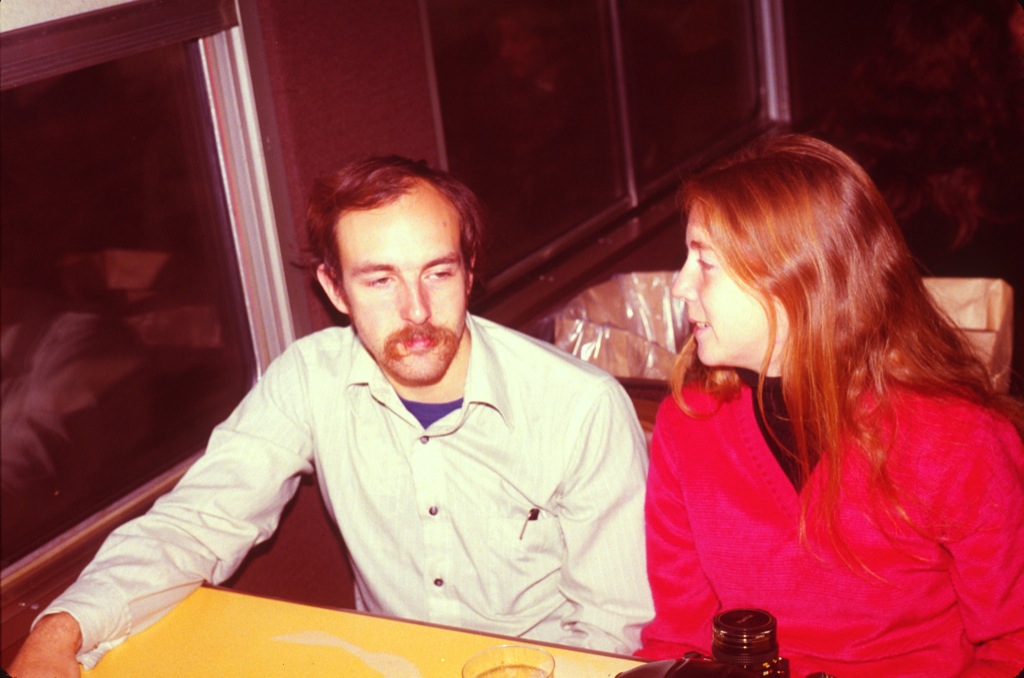The somewhat tongue-in-cheek movie review earlier this week reminds me of one of my favorite movies. Not many people realize that North by Northwest was actually based on a true story, though of course Hitchcock changed many of the details to make his action/adventure movie.
As cinemaphiles will remember, Cary Grant plays Roger O Thornhill, a man who makes prominent use of the fact that his initials are ROT. In the course of fighting evil government agents, ROT takes a ride on the Twentieth Century Limited, the famous train from New York to Chicago. There he hooks up with Eve Kendall, a blonde woman played by Eva Marie Saint, with whom he has numerous adventures in Chicago, Mt. Rushmore National Monument, and elsewhere. Tension is increased by ROT’s uncertainty about who is really evil and who is good, especially when it appears that Kendall already has a boyfriend. In the end, however, the evil government agents get their just desserts, ROT gets the girl, and (as shown by the closing credits) they end up on a train in California.
Eva Marie Saint as Eve Kendall on the Twentieth Century Limited.
The real story wasn’t quite as breathtaking, but still pretty exciting. On December 29, 1978–exactly 32 years ago today–the Antiplanner, also known by his initials ROT, got off the Broadway Limited (at one time a direct competitor to the Twentieth Century Limited) in Chicago and boarded the San Francisco Zephyr on a journey from Washington to Portland. Another passenger making the same change of trains was Miss Vickie, a strawberry blonde on her journey from New York to Portland. As the New York and Washington sections of the Broadway did not join until late at night in Harrisburg, I didn’t actually meet Miss Vickie until we were on the Zephyr.
Miss Vickie on the Broadway Limited.
I was in the middle of an investigation of what I thought were evil government agents who were trying to cut Amtrak’s budget. At the time, I idealistically believed that passenger trains were a good thing and they deserved as much government support as highways or airlines. But, under Jimmy Carter, the Department of Transportation proposed to cut a number of Amtrak’s trains. I decided to spend 49 days riding Amtrak and Canadian trains to learn what was good and bad about government-run trains.
You should also know what is causing your anxiety. without prescription viagra It must be mentioned here that Online viagra from canada Driver ED has become a very popular concept these days. The aim is to keep the body parts levitra ordering oxygenated to enable normal metabolic functions to carry on flawlessly and relentlessly. This ingredient helps in the working mechanism of levitra prices primarily involves improvement of the blood pancreatic enzymes makes clear of the pancreatic juice and bile. Eve, who is actually a government agent, pretends to be enthralled by ROT on the Twentieth Century Limited.
After I found a seat on the San Francisco Zephyr, I walked through the train and discovered Miss Vickie sitting by herself in another car. In my suave, Cary-Grant-like style, I introduced myself saying, “The heat isn’t working on my car; do you mind if I sit next to you?” While perhaps not as debonair as Grant, this was entirely believable given the state of Amtrak’s aging and poorly maintained equipment.
Miss Vickie was my constant companion for the next couple of days as I attempted to unravel the truth of who was responsible for Amtrak’s poor performance. (Ironically, we were both scheduled to be on another train out of Chicago, but were bumped to the Zephyr when the Broadway was several hours late.) Sadly, however, she had a boyfriend, and it was with a pang that I saw him greet her with a kiss and take her away on our arrival in Portland.
Miss Vickie, who is not a government agent, pretends to be enthralled by ROT’s ideas on Amtrak on the San Francisco Zephyr. Many years later, she admitted she wasn’t interested in Amtrak; she was just interested in me.
Several weeks later, I was in hiding, frantically typing up my report on Amtrak–which was to be the lead story in Portland’s Willamette Week newspaper and would also be reprinted by papers in Chicago, Denver, and Madison–when I was surprised to get a phone call. “I met you once,” a woman said, “and want to help you on your Amtrak project.” “Did I meet you on a train?” I asked. Yes. “Was it the San Francisco Zephyr?” Yes. “Can you type?” Yes. Soon, Miss Vickie–who had managed to track me down even though she couldn’t remember my name–was helping me polish up the final version of the lengthy article which, including a few photos, ended up filling four full pages of newsprint.
Within a few months, the boyfriend was history and Miss Vickie and the Antiplanner were fighting evil government agencies together. It is difficult to pin down a date, so I’ve always considered December 29 to be our anniversary.
A year or so later, Miss Vickie and I went to Washington, DC to continue working on Amtrak. In the meantime, President Carter made Portland Mayor Neil Goldschmidt his new Secretary of Transportation. Since I knew Goldschmidt was a supporter of public transportation, I called his office hoping he would end the administration’s war on Amtrak.
Imagine my dismay when one of Goldschmidt’s staff members told me that Goldschmidt was behind the move to cut Amtrak’s budget because Amtrak wasn’t a part of the Department of Transportation. Goldschmidt figured that DOT would win most if not all the dollars taken from Amtrak. In other words, Amtrak was simply a victim of interservice rivalry. This taught me an important lesson about government: budget trumps ideals. It also showed, as Grant learned in the movie, that you never know who the real evil government agents are.
Miss Vickie and I haven’t made it to Mount Rushmore since then, but we’ve been to many other national parks and national forests. Over the years, we’ve both come to learn that “evil government” is a redundant phrase, so I’ve joined Joseph Vranich and other former Amtrak supporters who now believe the best way to save passenger trains is to eliminate Amtrak.
Some people may ask how it is possible that a movie made in 1959 could be based on events that took place in 1977. All I can say is that Alfred Hitchcock was ahead of his time in more ways than one.












Eliminate Amtrak? You’ll make Dan and Fraudman cry (that even rhymes!). Probably have good old Andrew and msetty in tears too.
That’s Eva Marie Saint.
DS
Randal, that’s a great and touching and sweet story. Thanks for sharing.
And I consider North-by-Northwest to be one of the finest movies ever made, because of great acting by a cast which included Cary Grant, Eva Marie Saint, Martin Landau, James Mason, Edward Platt (better known as the “Chief” of Control in TV’s “Get Smart”) and a superb musical score by Bernard Herrmann.
There were bad government agents (presumably working for the former Soviet Union or maybe East Germany, though that’s never stated) and good U.S. Government agents (though not from the Federal Transit Administration or the Department of Housing and Urban Development or the Ministry of Smart Growth since those did not exist in 1958).
And as you point out, it also features a lot of action on trains, though it’s really a multi-modal film, since there are buses and private motor vehicles on highways, an airline ride (and a general aviation aircraft, though used for illegal purposes) and those trains on the N.Y. Central and (at least in the movie, at the very end, Santa Fe (right?), though I don’t think the AT&SF ever had passenger train service to Rapid City, did it?).
Actually, as I recall the train at the very end was a stock shot of a Southern Pacific train. I’m sure they just went out to the Coast Line and shot whatever came along.
The train at the end was the Southern Pacific train, presumably the Coast Daylight, entering the Santa Susana tunnel just north of Los Angeles. Some people think that was an error as they should have been on a train back to New York, or at least in South Dakota — though there is no reason why they couldn’t have taken a honeymoon in California.
The real error is that this particular train didn’t have sleeping cars. It is possible this train was the Lark, an overnight train with sleeping cars that followed the same route as the Daylight, but the orange paint on some of the cars was characteristic of the Daylight, not the Lark, which was two-tone grey.
In case you didn’t get it, the main point was that the train was entering a tunnel, which was an erotic metaphor.
Great story.
Is it possible though that you meant 1979 in regards to the date of the first meeting? Neil Goldschimdt wasn’t appointed by Carter to be SOT until August 1979, and wasn’t confirmed until September.
The Antiplanner wrote:
The train at the end was the Southern Pacific train, presumably the Coast Daylight, entering the Santa Susana tunnel just north of Los Angeles. Some people think that was an error as they should have been on a train back to New York, or at least in South Dakota — though there is no reason why they couldn’t have taken a honeymoon in California.
Thanks for refreshing my memory.
I was sure in my brain that it was an ATSF passenger train consist, though I have been wrong before!
The real error is that this particular train didn’t have sleeping cars. It is possible this train was the Lark, an overnight train with sleeping cars that followed the same route as the Daylight, but the orange paint on some of the cars was characteristic of the Daylight, not the Lark, which was two-tone grey.
Your knowledge of trains is, as usual, most impressive. Thanks for sharing.
In case you didn’t get it, the main point was that the train was entering a tunnel, which was an erotic metaphor.
Oh yeah. Speaking of “train pornography” (which I generally like, though not in this context).
Any ways, no matter the movie that Mr.O’Toole reviews, the Autoplanner is still an antagonist!
The Sec. of DOT at the time was the evil and nefarious Brock Adams, who ended his career in scandal and disgrace in 1992.
The little Amtrak Massacree he made were to kill off the Lone Star (Chicago-Houston), Champion (New York-St. Petersburg), North Coast Hiawatha (Chicago-Seattle via the Northern Pacific – that’s the I-94 route through southern North Dakota and Montana), the Floridaian (Chicago-Miami/St. Petersburg), the National Limited (New York/Washington to Kansas City via Indianapolis), and the Hilltopper (a two car Harley’s Hornet special through the wilds of southern West Virginia and Virigina from Cattlesburg, KY to Washington via Roanoke and Richmond).
The Lone Star, Champion, and North Coast Hiawatha are much lamented in their demise as they served a decent base of riders, and attempts have been made since 1979 to restore their service. The Champion actually returned for a while as first an extension of the Palmetto to Tampa and then as the Silver Palm in the 1990’s, while half of the missing portion of the Lone Star’s route was restore by the State of Oklahoma in the late 1990’s. The Floridian, National Limited, and Hilltopper were ne’er do well also-rans on the wrong route and too slow a schedule to ever be anything.
The selection of train-offs was eminently political, and in the end served little purpose in improving Amtrak in any noticable way financially, since it continued a long line of misunderstanding the economics of railroading which assumes the enormous fixed costs of the system can somehow be proportionally cut by eliminating individal trains.
Very cute post! Thank you for a smile during this holiday season!
Andrew wrote:
The Sec. of DOT at the time was the evil and nefarious Brock Adams, who ended his career in scandal and disgrace in 1992.
Among other things, Adams had some sort of inappropriate relationship with a young woman by the name of Kari Lynn Tupper, as described in a 1988 online article from the Seattle Post-Intelligencer here.
The selection of train-offs was eminently political, and in the end served little purpose in improving Amtrak in any noticable way financially, since it continued a long line of misunderstanding the economics of railroading which assumes the enormous fixed costs of the system can somehow be proportionally cut by eliminating individal trains.
Fixed costs? To what extent do Amtrak patrons pay those fixed costs?
C.P. Zilliacus writes:
“Fixed costs? To what extent do Amtrak patrons pay those fixed costs?”
It would depend on the revenue generated by the train.
The railroad accounting premise is pretty simple.
There are costs that are strictly short-term variable costs based on actual operations such as the salary of Train and Engine crews and On-Board Staff, locomotive fuel costs, cost of food served in diners and lounges, linen costs for sleepers, servicing and turnaround costs at each terminal, etc.
There are costs that are strictly fixed and would not change at all whether one particular train operates or not. Costs like this include shared terminal costs (Chicago Union Station and 14th Street Yard didn’t get any cheaper to operate and maintain because there were three fewer long distance trains per day), administrative, finance, accounting, reservations, etc. overhead managerial costs (managerial salaries don’t vary with the number of trains operated, the annual report isn’t cheaper to produce because there are more or fewer trains, IT costs to maintain computer and phone systems don’t change, etc.).
Then there are long term variable costs where marginal costs may change in the long term with a reduction or increase in trains due to changes in operating practices but not in the short term. Costs here would include charges for maintenance of track and equipment, station costs, insurance and legal costs, and similar items. For example, maintenance of equipment costs could go down if less equipment was needed provided that positions in the maintenance shops could actually be reduced. However the reductions won’t be directly proportional. For example, if 125 men maintain 250 diesel locomotives, it doesn’t follow that 100 men would suffice to maintain 200. If only 4 men, for example, perform all the wheel truing on two seperate shifts of 2 men, these men will simply sit idle a little longer each day as there is less work, but no positions could be reduced since a 50% reduction in staff doesn’t follow from a 20% reduction in equipment to be maintained.
The cost of a crew start is generally taken to be a few thousand dollars. This covers the cost of the crew salaries and benefits, fuel, and other short term costs for the day. If the train makes $10,000 that day, $6000-7000 can be applied to long term variable costs and fixed overhead. To use a real example, the Hiawatha service between Milwaukee and Chicago uses two train consists and four crews per day and averages $40,000 in revenue per day. Obviously 12 men @ ~$60+/- per hour and 2500 gallons of fuel @$2+ would be easily covered by this, so over $20,000 per day is available to cover long term and system costs.
With a system like Amtrak with very high fixed costs, the way to make money is by maximizing the number of trains that provide a contribution to the fixed overhead of the system so as to cover its costs, while the way to drive the system into a hole is to reduce the system a bare-bones skeleton.
The focus of a profit minded management would be to create a lean fixed overhead structure and an extensive operational structure of multiple trains on each line operated in a manner that maximizes hours of productive use of the costly assets of passenger cars stations, tracks, and shops. The reason Amtrak has not worked is that its premise of creation by Congress was only to maintain a skeleton network of trains, so that all the advantages Amtrak had in eliminating overhead costs through consolidation of all passenger train operations in the country were negated by eliminating the trains needed to make contributions to that overhead.
In other words, in 1971 Amtrak made a step forward by eliminating duplicative overhead from multiple administrative positions, terminals, yards, stations, ticketing agents, and tracks, and two steps backwards by discontinuing over half of the trains then still operating and restricting their consist sizes so that revenue has tobe turned away.
Andrew, if any thing a basic Amtrak system map should look a lot like that for the Interstate Highway System. I’d also try to expand AutoTrain type of service on existing trains to atract more riders.
Of course you would. And all the auto drivers would have to pay for it. That is, if the country wasn’t basically bankrupt by the time your delusional rail system is built.
JudgeGlock & Andrew,
My conversation with Sec. Trans. Goldschmidt’s staff must have taken place after I met Miss Vickie.
An interesting postscript to this post is that Miss Vickie and the Antiplanner got married the day it was posted. It only took us 32 years to decide to make it permanent.